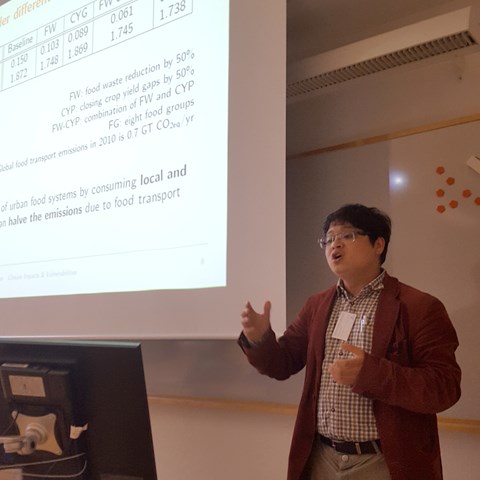The SLU Global Theme on Urban and Peri-urban farming hosted a panel at the DEVRES conference on ”The opportunities and challenges in urban and peri-urban agriculture and the role for science-based policies and practices.”
Today more than half of the planet’s inhabitants live in cities. The world-wide migration of rural people to cities is particularly prominent in Africa and Asia. Besides the demographic aspects, these dynamics do also change the conditions for agriculture, livelihoods and food production. There are new opportunities and challenges to which science can contribute. These relates to several of the Sustainable development goals.
People in cities and towns in low-income countries demand and eat a more varied diet than rural dwellers. This more varied diet comprises more legumes, fruits, meat, milk, egg and fish compared with the rural staple food-based diets. The demand for these different components opens for urban and peri-urban agriculture (UPA). This kind of farming is mainly small-scale and often operated by women, yet contributing to a significant share of the food in many cities in low-income countries. Also, the rural dwellers moving to cities often bring agricultural practices with them for income and food and nutrition security reasons. In addition, particularly the high value perishable products also create unique market opportunities, whereby UPA can become a deliberate accumulation strategy actively pursued by entrepreneurial women, men and youth from different socio-economic classes. In spite of its important role(s), there are often no policies about or infrastructure for UPA and sometimes it is even illegal but still practiced.
Unfortunately, there are also challenges related to UPA. For instance, threats to the public health from zoonotic diseases in livestock, sanitary issues from cultivation and livestock-keeping, and local environmental degradation from pollution. Analyzing the opportunities and challenges in UPA as well as suggesting policies or interventions to balancing the up- and downsides, sustainably develop the sector and integrate it into inclusive urban planning activities was the focus of the presentations and discussions in this panel. Thus, a multitudes of disciplines where represented in the panel.
Presentations took place during two sessions. Eight particpants presented their original research on various opportunities and challenges associated with urban and peri-urban agriculture. Together, they covered Africa and Asia, qualitative and quantitative methods, as well as drew on primary fieldwork and analysis of secondary data. Thematically, the researchers considered both livestock and crop sub-sectors, discussed climate and environmental challenges, and discussed gender inequalities.
Many pointed to the implications of their research for policy and practice. More specifically:
- Johanna Lindahl (ILRI / SLU) talked about urban livestock keeping in Hanoi, and its risks and benefits. She also pointed to policy implications.
- Ulf Magnusson (SLU) explored what sets livestock keeping in citys apart from that in rural areas, and focused on the viral zoonotic disease Japanese Encephalitis in Vietnam and the zoonotic bacterial infection brucellosis in Tajikistan.
- Gunnar Jacks (KTH) presented a study from Bamako, Mali, on innovative soil fertility enhancing measures. He highlighted how urine separating latrines followed by co-composting the urine with organic waste can substantially enhaced the soil structure and organic matter in the soils, as well as that used dry batteries (surprisingly enough!) contribute to fighting zink deficiency, a common problem in soils in Africa.
- Soulé Akinhola Adechian (Parakou University, Benin) talked about how strong and diverse social networks enhance indigenous leafy vegetables marketing in Benin, while noting that even if the majority of vegetable traders are women, men are the ones who are most successful in the marketing due to their stronger networks.
- Hayford M. Ayerakwa (University of Ghana) presented a study highligthing the unequal opportunities for female and male headed households (FHH/MHH) to engage in urban and peri-urban farming in Ghana, where MHH have much better access to land, at the same time as FHH to a much greater extent rely on own production for food. He argued that this may also explain why FHH are more food insecure than MHH.
- Johanna Bergman Lodin (SLU) presented a new project she will carry out together with Katarina Pettersson (SLU) on entrepreneurial urban and peri-urban agriculture in Dar-es-Salaam, Tanzania, where they will explore how this can be empowering for women, men and youth.
- Nuzhat Fatema (Khulna University, Bangladesh) talked about how ecosystem based adaptation (EbA) can contribute to building resilience in peri-urban coastal communities in Bangladesh. She made a review of research and highlighted the current bottlenecks and constraints for wider EbA adoption as well as presented policy suggestions for how to institutionalize EbA.
- Prajal Pradhan (Postdam Institute for Climate Impact Research, PIK) presented research drawing on data from 7000 urban areas across the globe on how the regionalization of urban food systems can halve carbon emissions from food transport. He also argued the need for decreasing the consumption of animal products, eating more seasonally based foods, for closing yield gaps and reducing food waste.
